Holistic beauty
on
Skin care

peer-reviewed
A feel-good soothing coriander seeds oil
with an innovative
well-being approach
ANDRÉA NIGON1*, ALICIA ROSO2, CÉCILE BIZE3, GAELLE VINCENT4, CATHERINE KERN5, CHRISTINE GARCIA6
*Corresponding author
1. Beauty Care Markets & Digital Manager, Seppic
2. Scientific Communication Manager - Research & Innovation, Seppic
3. Biological Evaluation Manager - Research & Innovation Unit for Applications, Seppic
4. Research technician - Biological Evaluation - Research & Innovation Unit for Applications, Seppic
5. Head of Biological Evaluation - Research & Innovation Unit for Applications, Seppic
6. Director of Research & Innovation Unit for Applications, Seppic
ABSTRACT: Trying to answer consumers’ quest of well-being, Seppic has developed a feel good soothing active ingredient from coriander seeds oil that acts on both skin and mind. Its performance to protect the skin from emotional stress damages was evaluated thanks to an innovative approach. First, it has demonstrated an acupuncture-like effect similar to a real acupuncture treatment thanks to an innovative in vitro protocol. Then, according to the results of in vitro tests, it has revealed its ability to protect happiness molecules and its ability to enhance skin comfort by protecting nerve extensions leading to the decrease of skin reactivity. Finally, the results of the self-evaluation and statistical analysis of the verbatims confirmed that it procures a sensation of well-being.
??????????????????
Introduction
During the last years, well-being has been at the forefront of daily concerns. Cosmetic consumers have started to understand that our body and skin are the reflection of our inner self and happiness. They are now looking for a connection that goes beyond physical appearance. That’s how people noticed that using a beauty care product can impact their sensations and emotions. They recognize that beauty care products go beyond physical criteria. Indeed emotional stress has a direct impact on both skin and mind, in particular by increasing the secretion of Corticotropin-Releasing Hormone. It leads to an increase in nitric oxide, a stress marker, causing oxidative damage and inflammation. It also induces the release of a “stress hormone” cortisol which decreases happiness molecule(1,2) levels such as β-endorphins and oxytocins. Moreover, it can also damage nerve endings leading to unpleasant sensations ranging from skin discomfort to pain. These mechanisms are creating a state of sensitive skin (3).
Taking that notion into account, Seppic has been looking for a natural extract that can access holistic beauty.
The Seppic Research & Innovation team has developed a patented natural coriander seed oil (INCI: coriander seed oil) extracted from coriander sourced and eco-cultivated exclusively in the South of France. Coriander is an historically well-known plant for its medicinal virtues used for many purposes, such as therapeutic, culinary and rituals, whether it be with its leaves, blossoms or seeds. Moreover it positively impacts biodiversity as it is a melliferous plant. It needs low quantities of raw materials and maintenance while growing on harsh lands that could not be used for other cultivations.
From its seeds, a special production method without involving solvents has been applied in order to design the ingredient in the most environmentally-friendly way and to ensure its good skin tolerance. Thanks to its composition rich of petroselinic acid, an uncommon omega-12 showing anti-inflammatory (4) and soothing properties, and linoleic acid, a fatty acid with a crucial role in the structure and function of the stratum corneum (5), this coriander seed oil, aligned with the recent holistic beauty trend, has demonstrated a feel good soothing benefit and a proven action targeting the skin and the mind, for an ultimate well-being experience. To demonstrate its full implication on the mechanisms of emotional stress, a whole innovative well-being approach has been developed. It is composed of an innovative in vitro acupuncture-like evaluation, in vitro measurements of the production of happiness molecules by cutaneous cells and neuron extensions after cortisol stress and a sensory and emotional evaluation.
“
“A study in healthy women providing probiotic yogurt for four weeks showed an improvement in emotional responses as measured by brain scans”
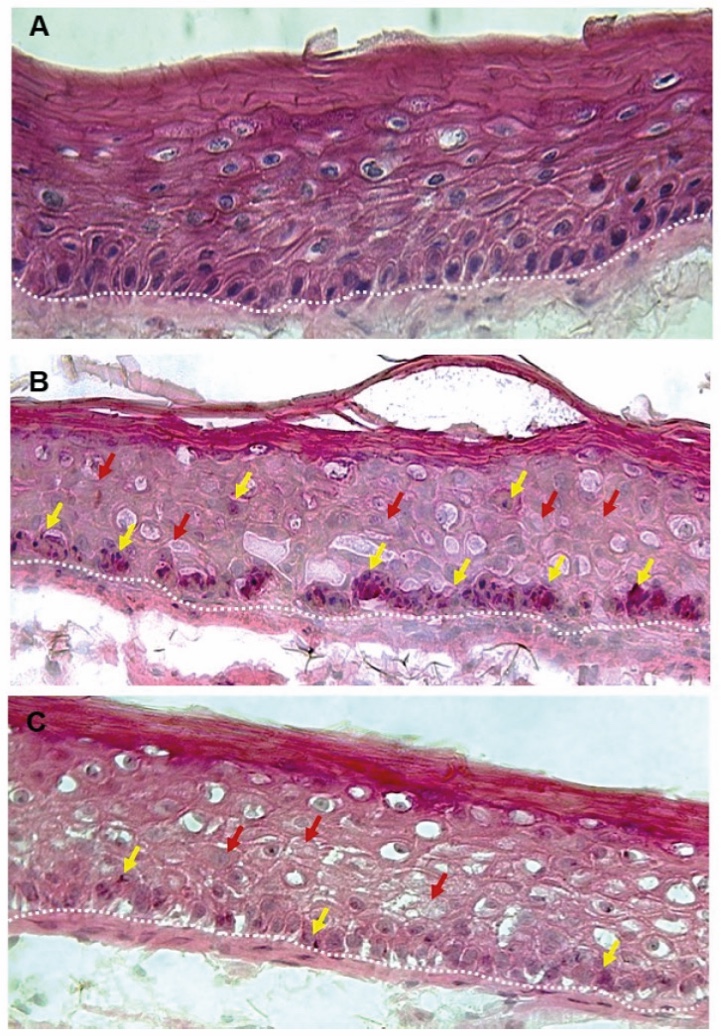
Figure 1. Skin Section with Microbiome. Most microorganisms live in the superficial layers of the stratum corneum and in the upper parts of the hair follicles. Some reside in the deeper areas of the hair follicles and are beyond the reach of ordinary disinfection procedures. There bacteria are a reservoir for recolonization after the surface bacteria are removed.
Materials and methods
Studies of major depressive disorder have been correlated with reduced Lactobacillus and Bifidobacteria and symptom severity has been correlated to changes in Firmicutes, Actinobacteria, and Bacteriodes. Gut microbiota that contain more butyrate producers have been correlated with improved quality of life (1).
A study in healthy women providing probiotic yogurt for four weeks showed an improvement in emotional responses as measured by brain scans (2). A subsequent study by Mohammadi et al. (3) investigated the impacts of probiotic yogurt and probiotic capsules over 6 weeks and found a significant improvement in depression-anxiety-stress scores in subjects taking the specific strains of probiotics contained in the yogurt or capsules. Other studies with probiotics have indicated improvements in depression scores, anxiety, postpartum depression and mood rating in an elderly population (4-7).
Other studies have indicated a benefit of probiotic supplementation in alleviating symptoms of stress. In particular, researchers have looked at stress in students as they prepared for exams, while also evaluating other health indicators such as flu and cold symptoms (1). In healthy people, there is an indication that probiotic supplementation may help to maintain memory function under conditions of acute stress.
MATERIAL & METHODS
MECHANISM OF ACTION & IN VITRO EVALUATION
a. Acupuncture-like anti-stress action
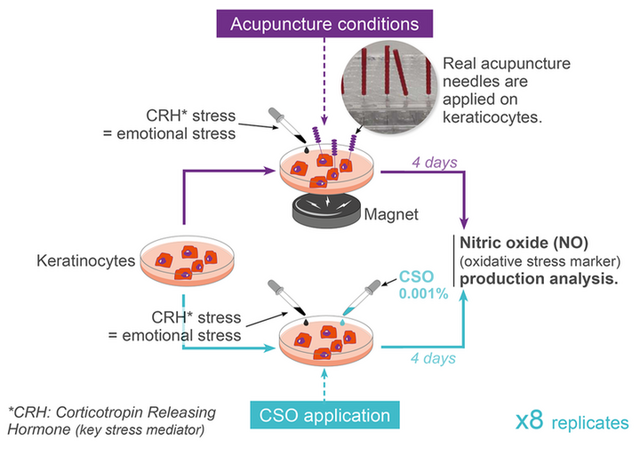
Figure 1. Acupuncture-like effect In vivo protocol measuring the properties of Coriander Seed Oil (CSO) to achieve an acupuncture-like effect.
Acupuncture (6) has been known in traditional Chinese medicine to rebalance the emotions and the mind, having a reducing effect on inflammation and oxidative stress (7). Keeping in mind that acupuncture has benefits on the skin, how to demonstrate that cosmetic active ingredients can achieve the same benefits, meaning without applying needles on the skin? That is how an innovative in vitro protocol has been developed. It consists of measuring the quantity of nitric oxide, an emotional stress marker found during emotional stress, produced by keratinocytes, after exposure to CRH (Corticotropin-Releasing Hormone) to determine the consequences of this psycho‐emotional stress on keratinocytes. The cells were co-treated with a CRH solution of 10μM and CSO (0.001%) and harvested 4 days later for further analysis. CRH is used in order to reproduce the over‐expression of nitric oxide released. Regarding the acupuncture conditions, the lids of the culture plates were replaced with lids with openings for the needles, and magnetized needles were inserted into those openings. Spontaneous nitric oxide (NO) release was measured at room temperature by using a NO-specific amperometric probe (ISO-NOPF, 100 μm diameter, 5mm length, World Precision Instruments, Aston Stevenage, UK) implanted directly in the culture media.
b.Happiness molecules protection
Oxytocins and β-endorphins are part of the happiness molecules family which are associated with confidence, empathy, wellness or reactivity to daily life pressure. Produced in the brain and in keratinocytes, they have an impact on adjacent nerve cells and are related to a natural anti-pain and well-being sensation allowing to reduce nerve cells sensitivity, enhancing skin comfort. It makes them a perfect neuro cosmetics target. To do so a test was performed on cutaneous cells exposed to stress by using cortisol, mimicking emotional stress, to assess their change in terms of happiness molecule production. For Oxytocin, the measurement was done on a co-culture of keratinocytes-neurons from induced pluripotent stem (iPS) (positive reference: β-endorphin at 10µM). To do so, human sensitive neurons were obtained from human induced pluripotent stem cells and human keratinocytes were seeded above neurons. Whereas for β-endorphins, the measurement was done on human primary keratinocytes isolated from a Caucasian donor.
c.Skin comfort enhancement
Damages to the nerve endings is seen as one of the main factors involved in skin reactivity. Hence protecting nerve extension could reduce cutaneous sensitivity (8). In order to assess skin comfort enhancement, a cortisol stress mimicking emotional stress was induced to a co-culture of keratinocytes and neurons to measure neuron extension and impact on nerves. Co-cultures were treated with CSO or its solvent, in the presence or absence of 0.1µM cortisol for 5 days. Then cells were fixed and beta-tubulin primary antibody was used to visualize neuron extensions (positive reference: β-endorphin at 10µM).
in vivo evaluation
The sensation and state of well-being generated by a product is as important as traditional in vivo measurements. Considering that the customer experience is relevant to prove the efficacy of an ingredient, a sensory and emotion evaluation was carried out. Coriander seed oil was tested in a double blinded, randomized clinical study on 2 groups of 31 subjects presenting sensitive skin, ranging from dry to mixed skin type. Coriander seed oil was added at 1% in a formula that was applied twice a day for 28 days on subjects in the control group.
Its sensorial action and “feel good effect” were evaluated in two ways: an open question “what do you think of the product you just used?“ examined by a neuroscience expert with a statistical analysis of the verbatim provided and a questionnaire to self-evaluate the feeling of well-being.
RESULTS AND DISCUSSION
MECHANISM OF ACTION & IN VITRO EVALUATION
a. Acupuncture-like anti-stress action

Figure 2.In vitro test measuring the properties of Coriander Seed Oil (CSO) to achieve an acupuncture-like effect (*** p<0.001 (vs control cells)
**p<0.01 (vs stressed cells))
By comparing the quantity of nitric oxide produced by keratinocytes on which have been applied either an acupuncture treatment or 0,001% coriander seed oil, it was demonstrated that in both cases the amount of nitric oxide is approximately the same and below the one achieved with the control. Hence, the action of coriander seed oil protecting cells from the stress impact was significantly similar to the one of acupuncture, and cells resulted significantly protected from stress. Coriander seed oil demonstrated an acupuncture-like effect.
b. Happiness molecules protection
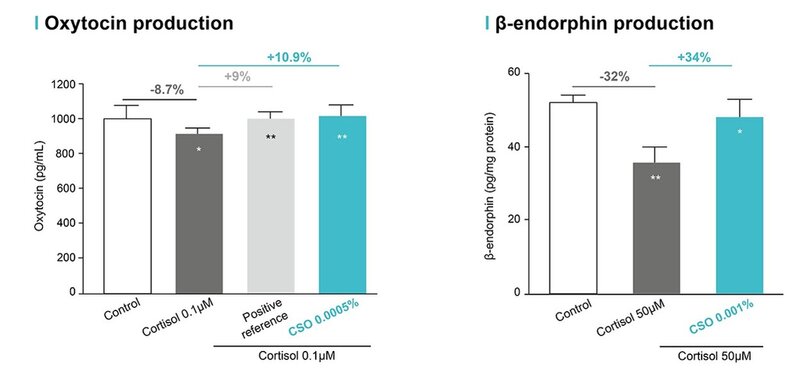
Figure 3. - In vitro tests measuring the properties of Coriander Seed Oil (CSO) to protect happiness molecules.
Seppic observed that when coriander seed oil is applied on stressed cells, oxytocin and β-endorphins levels are maintained. Hence coriander seed oil protects happiness molecules from emotional stress. The preservation of these “happiness molecules” shows a positive effect on nerve cells, reducing nociception (pain and itch sensation).
c. Skin comfort enhancement

Figure 4.In vitro test measuring the properties of Coriander Seed Oil (CSO) to protect neuronal extensions (Student’s t-test: ** p<0.01 /*** p<0.001).
The immunolabeling demonstrated the increase in intraepidermal density of nerve endings after adding coriander seed oil on stress cells with cortisol. Hence coriander seed oil shows a protective effect on nerve extensions resulting in a decreased skin sensitivity and reactivity.
IN VIVO EVALUATION
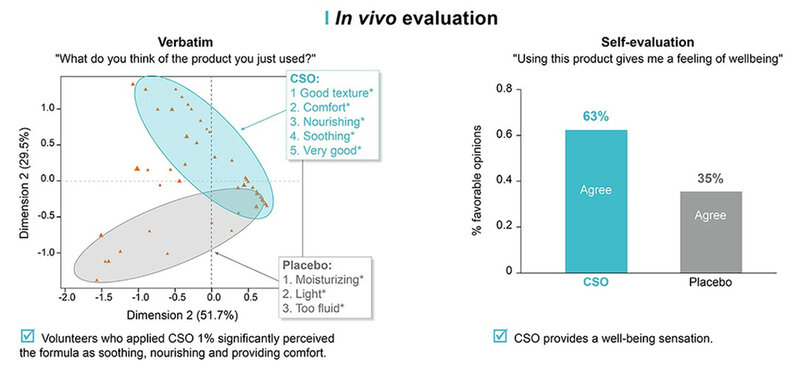
Figure 5.In vivo tests attesting the feel good sensation of Coriander Seed Oil (CSO) (Student’s t-test: * p<0.05).
Compared to the placebo formula, the formula with coriander seed oil was described by volunteers as “providing comfort, soothing, and nourishing the skin” and providing a “better sensation of well-being”. The results of the self-evaluation and the statistical analysis of the verbatims are going into the same direction which confirm that coriander seed oil procure a sensation of well-being.
Surfactant Applications

The application area lends itself particularly well to the use of AI. Active today in this area is the US company Potion AI (6). The company provides AI-powered formulation tools for beauty and personal care R&D. Their offerings include Potion GPT, next generation ingredient and formula databases and AI document processing. Potion’s work could have a significant impact on the entire surfactant value chain, from raw material suppliers to end consumers. By using their GPT technology, they can help target work toward novel surfactant molecules that have optimal properties for specific applications. By using their ingredient and formula databases, they can access and analyze a vast amount of data on surfactant performance, safety, and sustainability. By using their AI document processing, they can extract and organize relevant information from patents, scientific papers, and regulatory documents. These capabilities could enable Potion AI's customers to design and optimize surfactant formulations that are more effective, eco-friendly, and cost-efficient. A particularly interesting application for this type of capability is deformulation.
Deformulation is the process of reverse engineering a product's formulation by identifying and quantifying its ingredients. Deformulation can be used for various purposes, such as quality control, competitive analysis, patent infringement, or product improvement. However, deformulation can be challenging, time-consuming, and costly, as it requires sophisticated analytical techniques, expert knowledge, and access to large databases of ingredients and formulas.
AI can potentially enhance and simplify the deformulation process by using data-driven methods to infer the composition and structure of a product from its properties and performance. For example, AI can use machine learning to learn the relationships between ingredients and their effects on the product's characteristics, such as color, texture, fragrance, stability, or efficacy. AI can also use natural language processing to extract and analyze information from various sources, such as labels, patents, literature, or online reviews, to identify the possible ingredients and their concentrations in a product.
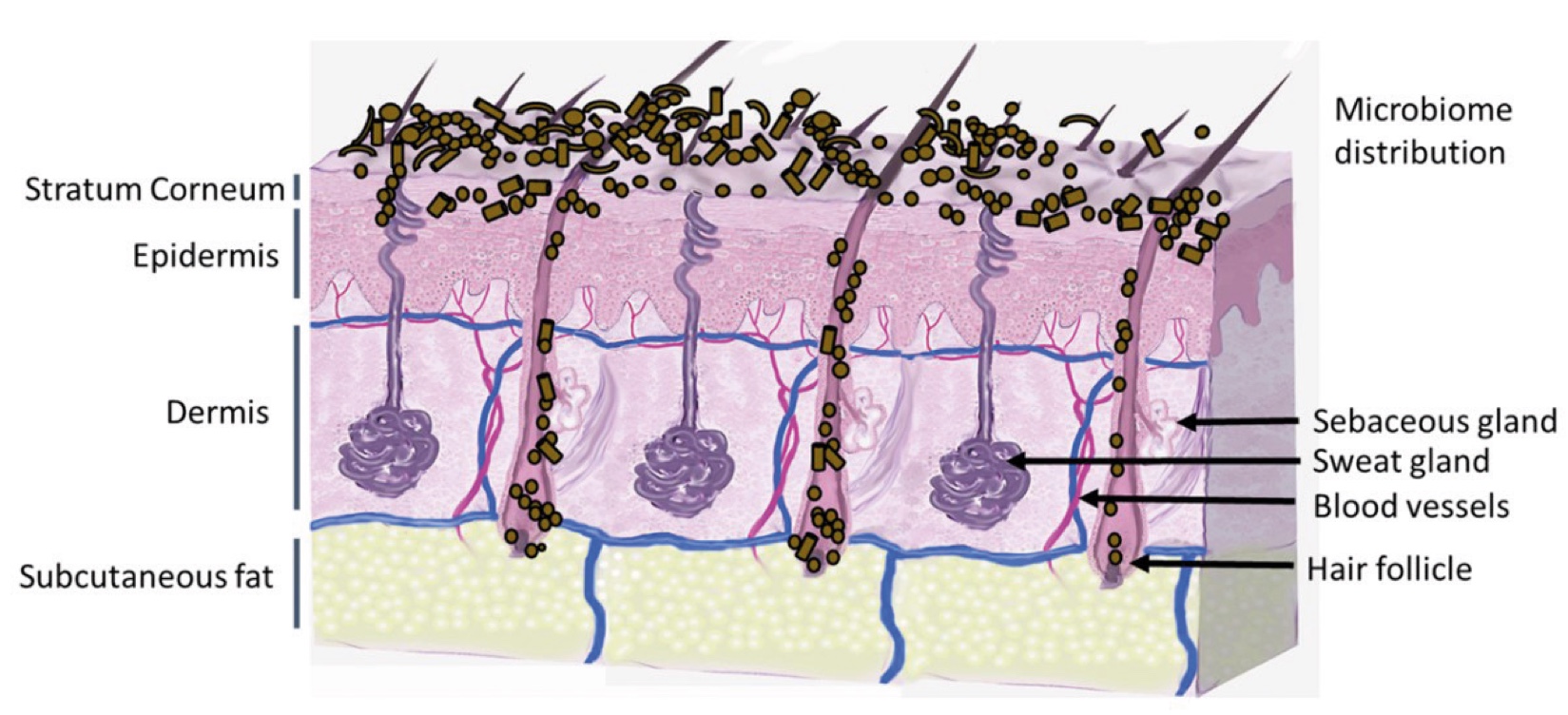
Figure 2. Skin Section with Microbiome. Most microorganisms live in the superficial layers of the stratum corneum and in the upper parts of the hair follicles. Some reside in the deeper areas of the hair follicles and are beyond the reach of ordinary disinfection procedures. There bacteria are a reservoir for recolonization after the surface bacteria are removed.
Conclusion
Coriander seed oil acts on the impact of emotional stresses on skin and limits the damage it induces. Its action on sensitive skin was assessed with some in-vitro tests, in which it showed its ability to reduce emotional stress markers, to protect happiness molecules (such as oxytocin and β-endorphin) from emotional stress, and to decrease skin reactivity by protecting neuronal extensions. Moreover, the sensory and emotional evaluation carried out confirmed the performance of it. Furthermore, it can fit cosmetic concepts as a natural oil providing holistic wellness on both skin and mind. For instance, it can suit creams, face masks, and massage oils.
For a holistic approach, Seppic’s offer includes a nutraceutical ingredient with a soothing and calming action on sensitive and reactive skin. Hence, by combining the nutraceutical and cosmetic grades it is possible to achieve an efficient duo, for a soothing inside out routine, with the same INCI name.
References and notes
- Dinas PC, Koutedakis Y, Flouris AD. Ir J Med Sci. 2011, 180, 319-325. DOI: 10.1007/s11845-010-0633-9
- Denda S, Takei K, Kumamoto J, Goto M, Tsunami M, Denda M. Exp Dermatol. 2012, 21, 535-537. DOI: 10.1111/j.1600-0625.2012.01507.x.
- Buhé V, Vié K, Guéré C, Natalizio A, Lhéritier C, Le Gall-Ianotto C, Huet F, Talagas M, Lebonvallet N, Marcorelles P, Carré JL, Misery L. Pathophysiological Study of Sensitive Skin. Acta Derm Venereol. 2016, 96, 314-8. Misery L. Peaux sensibles, peaux réactives. Ann Dermatol Venereol. 2019, 146, 585-591. DOI: 10.2340/00015555-2235
- McCusker MM, Grant-Kels JM. Healing fats of the skin: the structural and immunologic roles of the omega-6 and omega-3 fatty acids. Clin Dermatol. 2010, 28(4), 440-51. DOI: 10.1016/j.clindermatol.2010.03.020
- Catherine Kern, Christian Gombert, Alicia Roso and Christine Garcia; Soothing effect of virgin coriander seed oil on sensitive skin. Lipids and Cosmetics, 2020, 27, 7.https://doi.org/10.1051/ocl/2020043
- Pavão TS, Viannac P, Pillat MM, Machado AB, Bauer ME. Neurosci Lett. 2010, 484, 47-50. DOI: 10.1016/j.neulet.2010.08.016.
- Ho YS, Zhao FY, Yeung WF, Wong GTC, Zhang HQ, Chang RCC. Application of Acupuncture to Attenuate Immune Responses and Oxidative Stress in Postoperative Cognitive Dysfunction: What Do We Know So Far? Oxid Med Cell Longev. 2020, 13, 9641904. DOI: 10.1155/2020/9641904
- Misery L. Peaux sensibles, peaux réactives. Ann Dermatol Venereol. 2019, 146, 585-591. DOI: 10.1016/j.annder.2019.05.007
